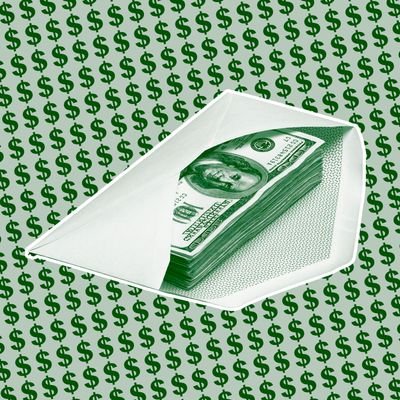
Are you soothed by the shuffle of crisp dollar bills being counted, stacked, sorted, and slid into labeled envelopes? Do you have trouble keeping track of where your own money goes? Allow me to direct you to the “cash-stuffing” phenomenon on TikTok. Also known as the “envelope method,” it’s a budgeting system where you pay for things only with the physical cash you’ve allotted for it. The idea is that when your precious paper dollars are tangible and accounted for, you’re less likely to fritter them away on, say, whatever sale tab is currently open.
Popularized by the radio personality (and questionable guru) Dave Ramsey over a decade ago, the original envelope method followed a strict formula. Every time you got your paycheck, you paid your fixed bills (housing, phone, etc.) and cashed the rest. Then you divided that cash between envelopes for each budget category (groceries, transportation, hobbies, etc.) and only spent what was in them. (In Ramsey’s words, “When it’s gone, it’s gone.”)
Versions of this strategy have helped a lot of people (including me) with their finances. You can even buy special pre-labeled cash binders and money holders on Amazon. But until recently, I hadn’t thought about the envelope system in years. Paying for everything with cash isn’t just annoying, it’s borderline impossible these days, sometimes even rude. (Just watch everyone’s faces in the line behind you when you start fumbling with bills at the checkout counter.)
Like most adults who are busy and hate carrying stuff, I also do most of my shopping online, where cash is just an abstract concept. But even if I didn’t, plenty of stores in my neighborhood are cashless. Plus, credit cards aren’t all bad — most offer benefits like points, better consumer protections, and opportunities to build credit. Or so I tell myself as I use them to pay for my life.
Still, the case for going cash-only is compelling. Research shows that using cash increases the “pain of paying,” also known as that sinking feeling of parting with your financial resources when you make a purchase (or even consider it). Other studies have found that when people use cash, they tend to spend less; they also feel more connected to the things they do buy. When I tried a version of the cash-only method years ago, it kept me accountable for my spending and helped me save a bunch of money.
So, how to square the advantages of cash budgeting with our frictionless, money-eating reality of cards and payment apps? When I spoke to people who incorporate cash stuffing into their day-to-day lives, they all admitted that it isn’t perfect, but it’s worth trying.
First and most importantly, you don’t need to go completely cash-only — think about what’s realistic. Most of your fixed bills (like rent and internet) are payable only by check or card. Don’t fight it.
Instead, focus more on the spontaneous spending that you do on the fly and actually need to budget for. You can also use cash stuffing for short periods of time — say, a month or a week or even a few days — to course correct if you’ve been overspending. It doesn’t always require the militant precision that you might assume.
In its strictest form, the envelope method involves divvying up your cash according to different budget categories, or “buckets,” and then spending it accordingly. But how does that actually work in practice?
For Carmen Perez, who stuck to the envelope method for four years to pay off $57,000 in debt, buy a home with her wife, and start her own business (she’s the founder of Make Real Cents, a financial-coaching service), it took some flexibility at first. “When I started out, my spending was all over the map,” she says. “Three out of five Americans have no idea how much they spent last month, and I was one of them.” She needed to track her expenses, and using cash worked better than anything else she tried.
Every two weeks, when Perez got paid, she’d withdraw cash for her budgeted spending and leave the rest in the bank (her savings and debt payments were automatically withdrawn from her account). Then she would spread the cash between her various expense categories. “I had envelopes for groceries, gas, going out, date-night money, therapy, Ubers, and upcoming trips,” she says. “If I spent money using a card, maybe for an Uber or to split a group dinner on Venmo, then I would just move the cash out of the corresponding envelope and deposit it back into my account the next time I went to the bank.”
It might sound complicated, but using cash made it easier for Perez to do the mental math of budgeting. “I managed all my spending two weeks at a time. If you have a certain amount allocated, in physical envelopes, it’s easier to know exactly how much you have left,” she says. Sure, sometimes she overspent a little bit in one area and had to dip into another envelope. “But that was fine. The envelopes were there just to provide organization,” she adds.
It was also important to budget realistically. “I wasn’t trying to be too restrictive,” she says. “I still had envelopes for fun things too, because I knew that if I didn’t, I’d be setting myself up to fail.”
If this still sounds overly try-hard and effortful, I get it. You could also take a more modified route. I know people who use cash selectively to curb spending in situations when they’re more likely to impulse shop. One of my friends doesn’t leave the house with more than $20 on weekends (and no cards for backup — although she could technically use Apple Pay on her phone, in a real emergency, but she’s never had to). When the $20 is gone, that’s it — she has to go home.
Another friend switches to cash when he comes home from a trip or has a period of heavy spending and wants to rein himself in. “I’ll just go to the bank, take out a chunk of cash, and try not to use any cards for a couple of weeks until the cash is gone,” he says. “It’s not a specific budget per se, but it creates more friction when I’m buying things. And I always wind up spending less than usual for as long as the cash lasts.” Sure, a cashier sometimes gives him a dirty look when he pulls out a wad of bills at the grocery store, he says. But for the most part, it’s a useful exercise.
I’ve tried going cash-only too. But instead of following a categorized budget (with certain amounts allocated for food, drinks, coffee, whatever), I’ll just give myself a maximum amount that I’m allowed to spend per day. If I spend less, whatever is left over gets rolled into the next day. It’s almost like giving myself an allowance.
Before this week, I hadn’t used my daily-allowance method for a couple of years. But once I reinstated it for a few days, I found it strangely satisfying and easier than I anticipated (like Carmen, if I use a card to pay for something, I just remove the cash that I’ve spent so that it “counts” against my daily total). Taking stock of my daily-cash allotment makes me feel more accountable; I’m responsible for giving those dollars a job to do, and I want to be thoughtful about it.
For now, I plan to stick with it for a while longer. At the very least, it’s reminding me that I’m not just a sieve that money passes through en route to buying clothes for my kid or groceries for dinner; I get to decide where it goes.
The Cut’s financial-advice columnist, Charlotte Cowles, answers readers’ personal questions about personal finance. Email your money conundrums to [email protected].


